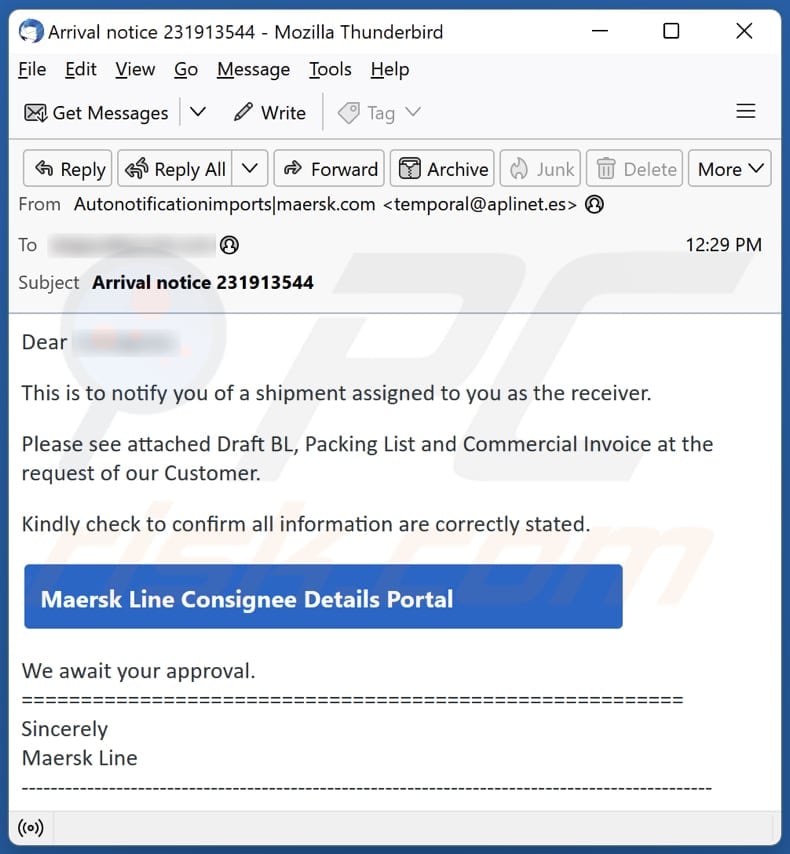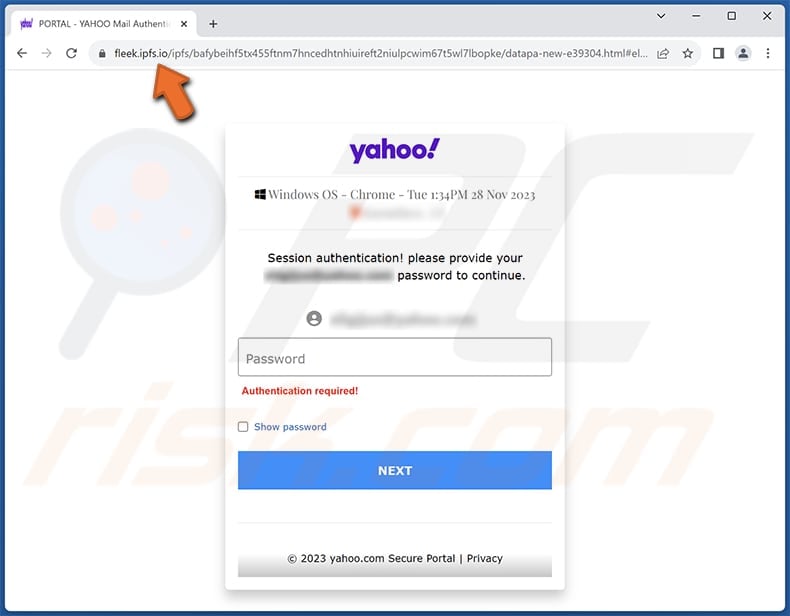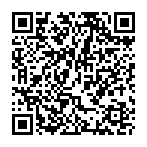How to recognize scams like "Maersk Line" email scam
![]() Written by Tomas Meskauskas on
Written by Tomas Meskauskas on
What is Maersk Line phishing campaign?
Upon examination, it has been established that this email is a fraudulent message sent by scammers posing as Maersk Line, a reputable shipping company. Scammers behind this email aim to trick unsuspecting recipients into opening the presented link and providing personal information. Emails of this nature are known as phishing emails.

More about the Maersk Line scam email
This phishing email, with the subject "Arrival notice 231913544", claims to notify the recipient of a shipment assigned to them as the receiver. It urges the recipient to review the attached documents, including a Draft Bill of Lading, Packing List, and Commercial Invoice, purportedly at a customer's request.
The email includes a link to a "Maersk Line Consignee Details Portal" for verification. However, the true purpose of this email is to trick the recipient into clicking the provided link, leading to a fake website. The goal involves phishing for sensitive information such as email account login credentials.
When the given link is clicked, it unveils a deceptive email service provider login form that prompts users to enter their password. Notably, the phishing page dynamically adjusts its design based on the recipient's email address. For example, if the recipient utilizes Yahoo Mail, the phishing page will mimic the appearance of the Yahoo Mail login page.
When scammers successfully steal email account login credentials, they gain unauthorized access to the victim's email account. Once inside, they may exploit the compromised account for various malicious activities. Common actions include searching for sensitive information such as personal details, financial data, or login credentials for other accounts.
Furthermore, scammers often leverage the compromised email account to launch phishing attacks on the victim's contacts. By sending deceptive emails from a trusted source, they attempt to trick others into divulging sensitive information or clicking on malicious links.
Also, scammers can try to use the stolen login information to access other accounts. If successful, scammers gain unauthorized access to other services, potentially including social media, financial, or e-commerce accounts. With access to multiple accounts, scammers can cause extensive damage.
| Name | Maersk Line Email Scam |
| Threat Type | Phishing, Scam, Social Engineering, Fraud |
| Fake Claim | Recipients should to review the attached documents |
| Disguise | Letter from Maersk Line |
| Symptoms | Unauthorized online purchases, changed online account passwords, identity theft, illegal access of the computer. |
| Distribution methods | Deceptive emails, rogue online pop-up ads, search engine poisoning techniques, misspelled domains. |
| Damage | Compromised email account (and possibly other accounts) loss of sensitive private information, monetary loss, identity theft. |
| Malware Removal (Windows) | To eliminate possible malware infections, scan your computer with legitimate antivirus software. Our security researchers recommend using Combo Cleaner. |
Similar scam emails in general
Phishing emails exhibit common characteristics designed to deceive recipients. These often include misleading content, urgent or alarming language to create a sense of urgency, disguised sender information, and attempts to manipulate recipients into taking specific actions, such as clicking on malicious links or providing sensitive information.
The emails frequently imitate legitimate institutions or services, aiming to trick individuals into divulging confidential data, such as login credentials or financial details. Examples of such emails are "ACH-ELECTRONIC FUNDS TRANSFER", "Requirements For Your Inbox Delivery", and "Password Reset Confirmation".
How do spam campaigns infect computers?
Users can inadvertently infect computers via email through malicious attachments or links. Common file examples used to deliver malware include executable files such as ".exe," script files like ".js" or ".vbs," and document files carrying malicious macros, such as ".doc" or ".docm." When users open these attachments or click on links, malware can be executed, compromising the security of their computer systems.
How to avoid installation of malware?
Install a trustworthy antivirus or anti-malware program and ensure it remains up to date. Regularly update other programs and the operating system. Be cautious when opening email attachments or links, particularly in unexpected emails or from unfamiliar senders. Download software or files exclusively from reputable sources, avoiding pirated or cracked applications.
Do not trust ads on shady websites and do not allow pages of this kind to send notifications. If you have already opened malicious attachments, we recommend running a scan with Combo Cleaner Antivirus for Windows to automatically eliminate infiltrated malware.
Text presented in the "Maersk Line" email letter:
Subject: Arrival notice 231913544
Dear -,
This is to notify you of a shipment assigned to you as the receiver.
Please see attached Draft BL, Packing List and Commercial Invoice at the request of our Customer.
Kindly check to confirm all information are correctly stated.
Maersk Line Consignee Details Portal
We await your approval.
Sincerely
Maersk Line
Screenshot of the phishing page presented in this email:

Instant automatic malware removal:
Manual threat removal might be a lengthy and complicated process that requires advanced IT skills. Combo Cleaner is a professional automatic malware removal tool that is recommended to get rid of malware. Download it by clicking the button below:
▼ DOWNLOAD Combo Cleaner
By downloading any software listed on this website you agree to our Privacy Policy and Terms of Use. To use full-featured product, you have to purchase a license for Combo Cleaner. 7 days free trial available. Combo Cleaner is owned and operated by Rcs Lt, the parent company of PCRisk.com read more.
Quick menu:
- What is Maersk Line phishing campaign?
- Types of malicious emails.
- How to spot a malicious email?
- What to do if you fell for an email scam?
Types of malicious emails:
![]() Phishing Emails
Phishing Emails
Most commonly, cybercriminals use deceptive emails to trick Internet users into giving away their sensitive private information, for example, login information for various online services, email accounts, or online banking information.
Such attacks are called phishing. In a phishing attack, cybercriminals usually send an email message with some popular service logo (for example, Microsoft, DHL, Amazon, Netflix), create urgency (wrong shipping address, expired password, etc.), and place a link which they hope their potential victims will click on.
After clicking the link presented in such email message, victims are redirected to a fake website that looks identical or extremely similar to the original one. Victims are then asked to enter their password, credit card details, or some other information that gets stolen by cybercriminals.
![]() Emails with Malicious Attachments
Emails with Malicious Attachments
Another popular attack vector is email spam with malicious attachments that infect users' computers with malware. Malicious attachments usually carry trojans that are capable of stealing passwords, banking information, and other sensitive information.
In such attacks, cybercriminals' main goal is to trick their potential victims into opening an infected email attachment. To achieve this goal, email messages usually talk about recently received invoices, faxes, or voice messages.
If a potential victim falls for the lure and opens the attachment, their computers get infected, and cybercriminals can collect a lot of sensitive information.
While it's a more complicated method to steal personal information (spam filters and antivirus programs usually detect such attempts), if successful, cybercriminals can get a much wider array of data and can collect information for a long period of time.
![]() Sextortion Emails
Sextortion Emails
This is a type of phishing. In this case, users receive an email claiming that a cybercriminal could access the webcam of the potential victim and has a video recording of one's masturbation.
To get rid of the video, victims are asked to pay a ransom (usually using Bitcoin or another cryptocurrency). Nevertheless, all of these claims are false - users who receive such emails should ignore and delete them.
How to spot a malicious email?
While cyber criminals try to make their lure emails look trustworthy, here are some things that you should look for when trying to spot a phishing email:
- Check the sender's ("from") email address: Hover your mouse over the "from" address and check if it's legitimate. For example, if you received an email from Microsoft, be sure to check if the email address is @microsoft.com and not something suspicious like @m1crosoft.com, @microsfot.com, @account-security-noreply.com, etc.
- Check for generic greetings: If the greeting in the email is "Dear user", "Dear @youremail.com", "Dear valued customer", this should raise suspiciousness. Most commonly, companies call you by your name. Lack of this information could signal a phishing attempt.
- Check the links in the email: Hover your mouse over the link presented in the email, if the link that appears seems suspicious, don't click it. For example, if you received an email from Microsoft and the link in the email shows that it will go to firebasestorage.googleapis.com/v0... you shouldn't trust it. It's best not to click any links in the emails but to visit the company website that sent you the email in the first place.
- Don't blindly trust email attachments: Most commonly, legitimate companies will ask you to log in to their website and to view any documents there; if you received an email with an attachment, it's a good idea to scan it with an antivirus application. Infected email attachments are a common attack vector used by cybercriminals.
To minimise the risk of opening phishing and malicious emails we recommend using Combo Cleaner Antivirus for Windows.
Example of a spam email:

What to do if you fell for an email scam?
- If you clicked on a link in a phishing email and entered your password - be sure to change your password as soon as possible. Usually, cybercriminals collect stolen credentials and then sell them to other groups that use them for malicious purposes. If you change your password in a timely manner, there's a chance that criminals won't have enough time to do any damage.
- If you entered your credit card information - contact your bank as soon as possible and explain the situation. There's a good chance that you will need to cancel your compromised credit card and get a new one.
- If you see any signs of identity theft - you should immediately contact the Federal Trade Commission. This institution will collect information about your situation and create a personal recovery plan.
- If you opened a malicious attachment - your computer is probably infected, you should scan it with a reputable antivirus application. For this purpose, we recommend using Combo Cleaner Antivirus for Windows.
- Help other Internet users - report phishing emails to Anti-Phishing Working Group, FBI’s Internet Crime Complaint Center, National Fraud Information Center and U.S. Department of Justice.
Frequently Asked Questions (FAQ)
Why did I receive this email?
Phishing emails are generally not personal. Instead, they are sent on a large scale to numerous recipients. The goal is often to cast a wide net and trick as many people as possible into revealing sensitive information.
I have provided my personal information when tricked by this email, what should I do?
If you have provided your email account login credentials, change your email password, check for any unauthorized account activity, and report the phishing incident to your email provider.
I have downloaded and opened a malicious file attached to an email, is my computer infected?
If the downloaded file was an executable (.exe), there's a significant chance of your computer being infected, as running such files commonly results in malware infiltration. Conversely, if the file was a document (.pdf, .doc, etc.), the risk of infection may be lower. Opening a document alone is sometimes insufficient for malware to compromise the system.
I have read the email but did not open the attachment, is my computer infected?
No, merely reading the email without opening the attachment does not infect your computer. The act of opening an email is harmless. It is clicking on links within the email or opening attached files that pose the risk of potential system infections.
Will Combo Cleaner remove malware infections that were present in email attachment?
Combo Cleaner is effective in identifying and removing nearly all recognized malware infections. Since sophisticated malware often conceals itself in the depths of the system, performing a comprehensive system scan is essential to ensure detection and elimination.


▼ Show Discussion